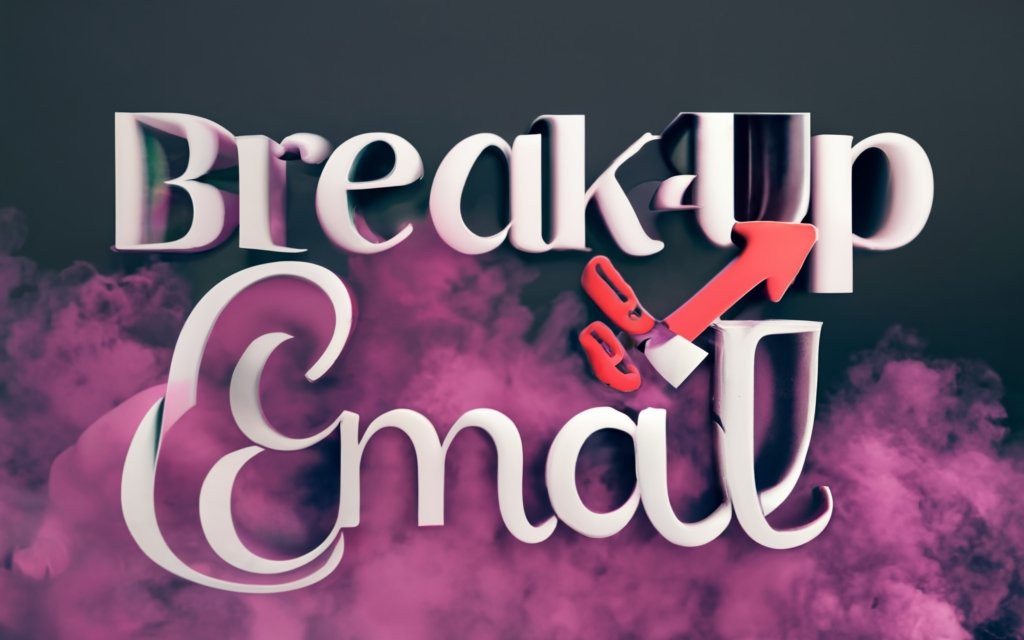Ending prospect relationships with class is a sales skill. This guide shares proven techniques to craft compelling “breakup email” subject lines, close loops with care, and handle rejection with grace.
Introduction
Sending a breakup email is one of the hardest parts of being in sales. You’ve invested time nurturing a relationship, had what felt like productive conversations, and gotten your hopes up that a deal was imminent. But then…radio silence. Your follow-up emails go unanswered and your calls straight to voicemail.
As painful as it is, this is the moment you have to face the music – it’s time to send a breakup email.
What Exactly is a Breakup Email?
A breakup email, also known as a “last attempt” or “closing the loop” email, is a final outreach you send when a prospect goes cold on you. It serves several purposes:
- Professionally ending the relationship and closing the loop of communication.
- Confirming if the prospect has any continued interest or if the deal is truly dead.
- Removing stale deals from your pipeline to focus on more promising opportunities.
Essentially, it’s a resignation letter from you to your prospect. But rather than make a clean break, a breakup email aims to give that one last nudge to see if the prospect might reconsider.
!Breakup email meme
Sending a breakup email feels like telling your crush it’s over, when you’re still kind of hoping they’ll dramatically win you back.
Unlike a typical sales email, a breakup email usually receives minimal response. But it’s not about the reply rate – it’s about closing the loop on a dead deal and freeing up your time for better opportunities.
Why Mastering the Breakup Email is Critical for Sales Professionals
Successfully ending prospect relationships in a classy yet compelling way achieves several benefits:
Keeps your pipeline healthy. Breakup emails help prune dead deals from your pipeline. Rather than carry them month after month, you confirm whether they’re still viable or ready to be closed-lost. This gives you and your sales manager an accurate forecast.
Saves you time. Following up indefinitely on cold prospects wastes precious selling time. A breakup email eliminates the back and forth, freeing up hours each week to devote to warmer leads.
Triggers a response. Even though replies are rare, a breakup email might jolt your prospect into responding – and possibly reconsidering. The urgency of a “last chance” email can prompt previously silent prospects to re-engage.
Creates a positive lasting impression. Despite the rejection, a breakup email lets you end things on a professional, courteous note. This keeps your personal brand and company brand top of mind for future opportunities.
Opens the door for future outreach. Breakup emails make it clear you’re ready to move on, but often extend the offer to reconnect down the road. This plants a seed for re-starting the sales cycle when timing may be better.
Provides closure. Even top-performing sales reps face constant rejection. Breakup emails provide psychological closure you need to brush off the loss and move forward.
Crafting a Compelling Breakup Email Subject Line
While the email body is important, the make-or-break factor for any breakup email is the subject line. This is your last chance to capture your prospect’s attention, which is no easy task after weeks of non-responsiveness.
An effective breakup email subject line needs to:
- Create urgency or curiosity to entice prospects to open and read your email
- Convey professionalism and respect for the prospect’s time and priorities
- Get straight to the point that this is your last attempt to connect
It’s a delicate balance to pique interest without seeming overly pushy or passive aggressive.
In this comprehensive guide, we’ll explore 10 proven breakup email subject line formulas along with real examples that get results. But first, let’s discuss when it’s time to pull the plug and say your final goodbye.

When Should You Send a Breakup Email?
Knowing the right time to send a breakup email is just as important as crafting the email itself. Send too soon, and you may prematurely end a relationship with a prospect who just needs a little extra nurturing. Wait too long, and you waste precious time that could be spent on riper opportunities.
So when is the “Goldilocks” moment that’s just right? Here are common signals that it’s breakup email o’clock:
After Multiple Unsuccessful Follow-Ups
This is the #1 indicator a breakup email is warranted. You’ve sent the prospect meaningful, personalized follow-up emails but heard nothing back. Specifically:
- You’ve sent at least 2 follow-up emails spaced 3-5 days apart with no reply.
- You’ve attempted to connect via other channels like phone and LinkedIn with no response.
- Your emails have not bounced or hit spam filters – the prospect is seeing them but choosing not to engage.
!Woman checking watch meme
At some point, silence becomes the prospect’s answer.
Of course the number of follow-ups depends on your relationship with the prospect. For an inbound lead, 2-3 emails may be enough. But for a long-nurtured outbound prospect, 5 or more follow-ups is often warranted before closing the loop.
Use your judgement based on factors like:
- Persona – Are they typically slow to respond? Very busy?
- Buying cycle stage – Are they just researching or close to a purchase?
- Past responsiveness – Have they gone long periods without replies before?
But regardless, if you’re emailing into a black hole, it’s time to speak up and confirm if the deal is dead.
Missed Meetings and Phone Calls
Another sign a breakup email is needed is if the prospect starts flaking on meetings and phone calls. Specifically:
- The prospect agrees to a meeting then cancels last minute with no attempt to reschedule.
- Your attempts to schedule a meeting are ignored.
- The prospect doesn’t show up to scheduled meetings without notice.
This avoids passive aggressive guessing of whether they really wanted to meet but got tied up. A breakup email removes doubt by giving them a chance confirm their interest.
!Missed meeting meme
At some point, you have to call them out for standing you up repeatedly.
However, be reasonable – one missed meeting because an emergency came up doesn’t warrant a relationship-ending email. But chronic cancellations, radio silence, and no-shows means it’s time to call the ball.
A Competitor Has Been Chosen
Sometimes prospects delay ending the relationship because they don’t want to hurt your feelings – like hesitating to break up because “it’s not you, it’s me.”
This is why it’s important to explicitly ask in a breakup email if they went with another solution. It gives the prospect an easy way to rip the bandaid off. And it prevents you from wasting any more time on a lost cause.
!Other girlfriend meme
Don’t be that person who refuses to accept their prospect chose someone else.
The key is asking in an ego-free way – make it clear you’re happy if they found a better solution and appreciate the consideration. This builds goodwill and they’ll remember you if the competitor doesn’t work out.
The Deal Has Stalled
Let’s say conversations were progressing nicely initially. But suddenly the prospect stops responding to questions about needs, budget, or next steps.
This lack of traction is a sign they’ve lost momentum and interest. The breakup email should focus on:
- Reminding them of the value your solution provides.
- Understanding if their priorities have changed.
- Offering an easy way to restart the conversation when the timing is better.
Essentially, it gets their stalled car a jump start or gives you permission to stop pushing them uphill. Either way, it moves things off dead center.
!Pushing car meme
At some point you have to stop pushing them uphill alone.
The key with stalled deals is being direct but empathetic. The breakup email makes it easy for the prospect to share what changed and if your solution still fits.
When Prospects Say Yes but Never Take Action
One of the most frustrating situations is when a prospect keeps saying they want to move forward but then disappears when it’s time for follow-through. Telltale signs include:
- They agree verbally to a proposal but never sign the contract.
- They ask for a contract to review internally but never provide feedback.
- They accept a meeting invite or say “let’s connect next Tuesday” but fail to show up when the time comes.
This “yes man” who never follows through wastes massive time and mental energy. The breakup email gives them an ultimatum – take action or you’re moving on.
!Agreeing meme
At some point, you have to call their bluff if they keep saying yes but never following through.
These types of prospects often have high enthusiasm and low intent. The breakup email forces their hand – they either convert or you can stop investing time in a mirage deal.
The takeaway is send the breakup email once you have concrete evidence the deal has sputtered. Let data, not emotion, direct the decision. While rejection never feels good, ripping the bandaid off quickly is better than prolonging a dead end relationship.
Now let’s discuss how to craft a compelling subject line to give your breakup email the best chance of getting a response.

Crafting a Breakup Email Subject Line That Converts
If you want your breakup email to be opened, read, and potentially elicit a response, the subject line is crucial.
Let’s explore what makes an effective breakup email subject line, common mistakes to avoid, and 10 proven examples that get results.
Goals of a Good Breakup Email Subject Line
The subject line of your breakup email needs to accomplish three things:
1. Create urgency and curiosity. Your prospect has been ignoring you for weeks, so your subject line needs to jolt them to pay attention and open your email. Short, clear phrases that imply finality work best.
2. Convey respect. Avoid aggressive wording that might put the prospect off. Maintain professionalism to preserve the relationship, even during the breakup.
3. Close the loop. Include verbiage that signals this is your last attempt to connect and resolve things. The prospect should clearly grasp you plan to move on.
It’s a tricky balance. You want to pique their interest without seeming bitter or overly pushy.
Best Practices for Crafting a Strong Breakup Email Subject Line
Follow these best practices when writing your subject line to maximize effectiveness:
- Keep it short – 6 to 10 words maximum.
- Put key phrases first – Leading with “Final follow up” or “Last attempt” conveys urgency upfront.
- Use their name – Adding the prospect’s first name personalizes the message.
- Refer to past conversations – Jog their memory by mentioning specifics like “regarding [project name].”
- Ask a clear question – Compel action by saying “Permission to close your file?”
- Include your company name – Branding aids recognition and credibility.
- Add time pressure – “Expires Monday” creates a fear of missing out.
- Test options – Use A/B testing to determine which convert best.
Common Breakup Email Subject Line Mistakes
On the flip side, there are some poor practices that can tank your open and response rates:
- Using overly aggressive words – Like “final notice” or “last warning” or “urgent.”
- Making it too long – Keep things laser focused with 6-10 words max.
- Being too vague – Avoid generic phrases that could apply to any email.
- Forgetting their name – Personalization is a must for relationship emails.
- Apologizing preemptively – Don’t say “sorry to bother” – be tactfully direct.
- Try hard humor – Lighthearted is fine but don’t be too silly or cute.
- Copying competitors exactly – Put your unique spin on proven formulas.
Less is often more with breakup email subject lines. The goal is capturing attention professionally while efficiently closing the loop.
10 Highly Effective Breakup Email Subject Line Examples
Now let’s look at 10 breakup email subject line examples that combine the best practices we just discussed:
1. Permission to close your file?
This works because:
- It’s short and to the point at only 6 words.
- Asks a clear yes/no question that compels a response.
- Implies finality that you plan to move on shortly.
2. Final follow up
This works because:
- Gets straight to the urgency that this is the last attempt.
- Very simple and skimmable at only 2 words.
- Leaves no doubt this relationship is ending soon without reply.
3. Before I go…
This works because:
- Creates curiosity about what you still need to say before closing this chapter.
- Hints at finality in a gentle, conversational way.
- Provokes opening without being overly aggressive.
4. Are you still interested in [goal]?
This works because:
- Reminds them specifically what we had discussed accomplishing together.
- Gives an easy yes/no response option about their continued interest.
- Implies you are ready to move on if the goals have changed.
5. Should I stop reaching out?
This works because:
- Gives the prospect total control by asking directly.
- Puts the ball in their court to take action if relevant.
- Indicates you don’t intend to keep emailing indefinitely without guidance.
6. I wanted to check in one last time
This works because:
- Hints it’s now or never if they want to continue exploring.
- Provides urgency but in a consultative way.
- Implies this relationship is ending soon without engagement.
7. Thanks for your time
This works because:
- Conveys respect and appreciation for the prospect’s consideration.
- Avoids desperation by graciously accepting the non-response.
- Subtly signifies you are ready to stop pursuing them.
8. Moving forward
This works because:
- Gets straight to the point that you plan to move on shortly.
- Implies closure without formally saying goodbye.
- Creates urgency to re-engage now or get left behind.
9. One last attempt
This works because:
- Bluntly states your days of following up are numbered.
- Sparks a bit of guilt that this is your last life line.
- Urgency to reply before you walk away for good.
10. I’m here if you change your mind
This works because:
- Low pressure way of extending a final olive branch.
- Keeps the door open should their needs or timing change.
- Gracefully frees you from chasing while the ball is in their court.
The takeaway is to be brief, direct, personal, and subtly convey urgency and finality. Test options to see what resonates best with your audience.
Now let’s explore how to customize your breakup email subject line specifically for each prospect.

Personalizing Your Breakup Email Subject Line
While there are proven formulas for effective breakup email subject lines, personalization is key to improving open and response rates. Let’s discuss how to customize your subject line for each prospect.
Use Their First Name
Including your prospect’s first name makes a big difference in opening and response rates for a couple reasons:
- Adds a human touch – The email feels like an outreach between people rather than companies.
- Increases curiosity – People are more compelled to open emails addressed directly to them.
For example:
Generic: Final follow up
Personalized: Final follow up, Sarah
You likely have been using their first name in previous emails, so continuing that personal tone with the breakup solidifies you have an established relationship.
Reference Past Conversations
Jog their memory of your past interactions and shared goals by referencing specifics, like:
- A project name you discussed
- Pain points or challenges uncovered
- Requests they made that you aimed to resolve
Reminding them of previous conversations makes it harder to ignore. For example:
Generic: Thanks for your time
Personalized: Thanks for discussing Project XYZ
This taps into consistency bias – people want to be consistent with views stated earlier. Referencing past conversations triggers that desire to follow through rather than be seen as flaky.
Tailor It To Their Needs and Interests
Think about what originally got this prospect interested and engage with that specifically:
- Their role – Finance directors care about ROI, Engineers about technical specs.
- Their industry – Healthcare has different concerns than manufacturing.
- Their unique needs – Which you discussed and aimed to meet.
This might mean saying:
Generic: I wanted to check in one last time
Personalized: I wanted to check in re: [their specific needs]
When prospects see you remember what matters to them, they pay more attention. It shows this is a tailored outreach, not a generic spray and pray email.
Put Your Shared History to Work
Look back through your existing email chains or CRM records for nuggets you can reference, like:
- A conference you both attended
- Colleagues you have in common
- Previous projects they mentioned
- Confirming their preferences that you discussed
Leveraging your shared experiences and conversations differentiates your outreach from impersonal sales spam.
For example:
“Hoping to reconnect re: [project] we discussed at [conference] last month”
Strike the Right Tone
Factor in their communication style when personalizing your subject line:
- Friendly – Use casual phrasing like “Checking in!”
- Formal – Keep it buttoned up with “Following up on our discussion”
- Playful – Try humor if that’s been your rapport
Matching their tone builds psychological safety to reopen communication without awkwardness or bitterness on either side.
The key is making your subject line feel like a personalized reach out between people with history, not a bulk sales email.
Take a quick look back through your existing conversations before drafting your breakup subject line and leverage those details. It can be the difference between being ignored again and getting a reply.
Now let’s look at how you can use A/B testing to optimize and improve future breakup email subject lines.

A/B Testing Breakup Email Subject Lines
A/B testing is a powerful technique to determine which breakup email subject lines get the best response from your prospects.
Why A/B Test Your Subject Lines
Every prospect and industry is different, so what works well for one may fall flat for another. The key is continually testing and optimizing to maximize your open and response rates.
Benefits of A/B testing breakup email subject lines include:
- Find your highest converting phrases – Test 10+ variations to determine which subject lines have the most impact.
- Adapt for different personas – See which subject lines resonate best with key prospect demographics.
- Stay on top of trends – If open rates dip on an old standby subject line, swap in something new.
- Increase responses – Apply learnings to future outreach for continuously better results.
How to A/B Test Breakup Email Subject Lines
Conducting an A/B test is straightforward:
- Identify variables to test – For example, including/excluding the prospect’s name, mentioning your offering, using humor, etc.
- Create multiple subject line versions – Such as “Last follow up, Sarah” vs “Final attempt re: [offering]”
- Split your outreach list – Send version A to half your prospects and version B to the other half.
- Analyze results – See which version had higher open and response rates.
- Apply learnings – Use the better performing subject line going forward.
- Continue optimizing – Test new variables and alternatives to keep improving.
To enable valid statistical analysis, each test needs a sufficient sample size – typically at least 50 prospects per variation.
Tools to Use for A/B Testing
Conducting manual A/B testing quickly becomes tedious. Leverage tools like:
- Email marketing software – MailChimp, Constant Contact, HubSpot, etc. make it easy to A/B test email campaigns.
- CRM systems – Many CRMs like Salesforce allow A/B testing workflows and templates.
- Google Optimize – Google’s free A/B testing tool works well for basic email tests.
- Dedicated email testing tools – SplitKit, Omnisend, MailerLite, and Klaviyo offer robust email testing capabilities.
These tools remove manual effort by automatically splitting your list and tracking open and click rates for each version.
Analyzing Results and Applying Learnings
The most important step is studying your test results to guide future subject line optimization.
- Statistical significance – Use tools like AB Tasty’s calculator to validate a real difference exists between the variations.
- Open and click rates – Look at both open rate and clicks on the “view email” link to identify the most compelling subject lines.
- Conversion rate – Most importantly, see if one variation resulted in more confirmed conversions.
- Prospect characteristics – Break down response rates by persona, industry, etc. to find segment-specific learnings.
- Timing trends – Note if a subject line becomes stale over time as prospects become desensitized.
Continually test new variables – including/excluding company branding, promoting free resources, using urgency cues like “expires soon” etc. Rinse and repeat the process to keep improving over time.
A/B testing takes some upfront effort but pays dividends by steering you towards subject lines scientifically proven to spark interest and re-engage otherwise cold prospects.
Now let’s look at writing the rest of your breakup email in a sensitive, professional manner.

Sending a Breakup Email with Sensitivity and Professionalism
While your subject line aims to capture attention, the body of your breakup email must maintain a sensitive, professional tone. Here’s how to end the prospect relationship with respect.
Avoid an Accusatory Tone
It’s tempting to ask why they’ve been ignoring you or call out their lack of response. But finger pointing will only put them on the defensive and damage your reputation.
Instead, acknowledge communication has lapsed without assigning blame:
- “I haven’t heard from you in a while, so wanted to check in.”
- “It’s been a few weeks since we last spoke, hoping all is well.”
This constructive tone sets the stage for a positive resolution, not heated confrontation.
Express Understanding of Their Priorities
Rather than acting entitled to more of their time, be empathetic about where you fall on their priority list:
- “I know you have a lot going on right now and likely can’t dedicate more time to our discussion.”
- “If this is no longer a priority, I completely understand and just ask that you let me know.”
Giving them an easy out avoids putting them on the spot or making them feel guilty if they can’t engage further.
Provide an Easy Way To Re-Engage
While you plan to move on, provide a simple CTA for them to respond if they want to restart conversation:
- “If you’d like to reconnect on this, simply reply and let me know.”
- “If your plans have changed and you want to discuss further, I’m happy to jump back on a call.”
Don’t force decisions on them. Make it easy to opt back in rather than demanding an outright yes/no response.
Offer a Last Bit of Value
Rather than asking for more from them, offer one last piece of helpful advice or resources:
- “Here are a few links that may be helpful for [their goals].”
- “I recently published a [relevant article/guide] that outlines some key strategies I’d recommend.”
Position yourself as truly invested in their success, whether or not it involves your solution.
Convey Appreciation
Thank them sincerely for considering your offering and for their time speaking previously:
- “I appreciate you taking the time to discuss and learn more.”
- “It was great speaking over the past few weeks and learning about your needs.”
Gratitude preserves the relationship, rather than torching bridges through bitterness or resentment.
The overall theme is separating your ego from the outcome. Make it easy for prospects to disengage guilt-free while keeping the door open through helpfulness and understanding.
This professional approach ultimately wins more customers when circumstances change down the road. Even if they don’t reply, you leave a positive impression.
Now let’s look at how to circle back if you don’t receive a response and need to fully close the loop.

Following Up After a Breakup Email for Maximum Impact
Just because you’ve sent a breakup email doesn’t always mean the relationship is over. Here are some best practices for maximizing impact with follow-up outreach.
Circle Back If No Response
If your breakup email goes unanswered, it’s appropriate to send 1-2 more follow-ups to confirm closing the loop.
However, avoid desperate sounding messages like:
- “Please just let me know if you’ve decided to go elsewhere.”
- “I’d really appreciate if you can provide closure here.”
Instead, politely reiterate next steps, like:
- “I just wanted to check are you OK with me closing your file at this point?”
- “Unless I hear otherwise, I’ll assume we’re agreed to end our current discussion.”
Make it easy for the prospect to respond, but don’t plead for engagement.
Provide Additional Value
Rather than asking for a response, offer something useful like:
- A relevant eBook, tip sheet, or blog digest
- Introductions to colleagues who can help with their goals
- Recommendations for other vendors who may be a better fit
Sometimes prospect interest wanes simply because priorities shifted. Useful content demonstrates you’re invested in their success, not just making a sale.
Set a Clear Timeline for Following Up
Avoid endless badgering by setting a timeframe for circulating back, like:
“I’ll plan to check in again in 6 months unless I hear from you sooner.”
Giving a specific date prevents you from following up preemptively and lets prospects know when to expect you.
This helps both parties avoid awkwardness of a never-ending sales process when interest has clearly waned.
When It’s Truly Time to Close the Loop
At a certain point, you need to accept defeat and move on if all follow-up goes ignored.
Signs it’s time for a closed-lost verdict:
- You’ve sent a breakup email plus 2 follow-ups with no reply.
- It’s been 2+ months since your last substantive communication.
- The prospect told a colleague they went with another solution.
Rather than endlessly holding out hope, prune stale leads from your CRM and pipeline. Focus energy where there is active two-way conversation.
Sometimes following up once or twice post breakup email revives deceased deals. Other times, the additional outreach just confirms the relationship has run its course.
Have discipline to accept either outcome, and gracefully move forward in a way that maintains your credibility.
Now let’s summarize some key takeaways from this guide on mastering breakup emails.

Key Takeaways for Crafting the Perfect Breakup Email Subject Line
Let’s summarize the core lessons for writing compelling breakup email subject lines that get results:
Best Practices for Breakup Email Subject Lines
Follow these best practices whenever drafting your breakup email subject line:
- Keep it concise – Stick to 6-10 words maximum.
- Lead with an urgency cue – Like “Final follow up” or “Last attempt.”
- Personalize with their name – “Final follow up, Sarah” builds rapport.
- Refer to past conversations – Jog their memory by mentioning specifics discussed.
- Ask a clear question – Compel action with “Permission to close your file?”
- Add time pressure – “Expires Monday” creates urgency.
- Test different versions – A/B test to determine which subject lines convert best.
- Match their tone – Keep it professional, casual, or playful based on past rapport.
- Remind them of value offered – For example, “Hoping to still help you achieve [goal].”
Common Breakup Email Subject Line Mistakes to Avoid
On the flip side, these poor practices can torpedo your open rates:
- Using aggressive words like “final notice” or “last warning.”
- Making the subject line overly long and wordy.
- Being too vague or generic.
- Forgetting to include the prospect’s first name.
- Apologizing preemptively for the outreach.
- Attempting overly casual humor that falls flat.
- Copying competitors’ subject lines too closely rather than putting your unique spin.
The sweet spot is subject lines that are brief, personalized, subtly convey urgency, and close the loop professionally.
Focus on Sparking Engagement and Closing Out Professionally
Remember, breakup emails have two simultaneous goals that require nuanced handling:
1. Capturing the prospect’s attention with compelling subject lines that stood out from the spam.
2. Ending the relationship with care and respect through graceful, consultative language.
With the best practices in this guide, you can tactfully accomplish both. Thoughtfully crafted breakup emails remove stalled opportunities from your pipeline while preserving your credibility. Combining urgency with empathy, directness with understanding – that’s the art of the perfect breakup.
Now let’s look at how you can start applying these techniques today.

Start Testing and Optimizing Your Breakup Emails Today
Now that we’ve explored best practices for breakup emails, here are some ways to start implementing what you’ve learned.
Audit Your Current Breakup Emails
Take a look at the last few breakup emails you sent out to prospects:
- Would your subject line catch your attention if you received it cold?
- Is the subject line personalized and professional?
- Does the email body tactfully close the loop?
- Did you express understanding and offer help without expectations?
Identify any areas that could be improved based on the recommendations in this guide.
Create Some Test Breakup Email Templates
Draft 2-3 breakup email templates you can use as starting points when parting ways with prospects:
- An empathetic template for prospects you have an established relationship with
- A more direct template for prospects you’ve had limited interactions with
- A breakup email strictly focused on closing the loop professionally
Have these on hand to quickly customize and send out tacit breakup messages.
Test Different Subject Line Variations
Use A/B testing to determine which of your subject line variations get the highest open and response rates:
- Test including vs. excluding the prospect’s name
- Try urgency cues like “final follow up” vs. softer phrases like “checking in”
- Experiment with mentioning your solution vs. keeping it generic
Crunch the data to guide future subject line optimization.
Set Up Follow-Up Workflows
Create organized workflows for what happens after you send the initial breakup email:
- 2 follow-up emails spaced a week apart if no response
- Closing the loop in your CRM after 2 weeks of silence
- Setting a task to re-engage in 6 months
Systematize your post break-up cadences so they happen automatically.
Learn From Every Breakup Email
Treat every breakup email as a learning experience:
- Note if certain industries or personas respond better to different approaches
- Watch for trends in which subject lines lose effectiveness over time
- Track if following up with content offers improves re-engagement
Continuously refine your process to maximize closed loop conversations.
Breakup emails are never fun. But mastering them helps you keep a healthy pipeline, maximize your time, and build strong relationships – even during rejection. Apply the strategies in this guide to turn breakups from necessary evils into positive productivity tools.
Your prospects are waiting!

Summary on Mastering Breakup Emails
Breaking up is hard to do – but mastering the art of the breakup email enables you to keep a healthy pipeline and strong prospect relationships.
Here are the key lessons to cement your breakup email prowess:
- Know when it’s time – Don’t jump the gun, but don’t wait forever either. Signs like repeated non-responses make it clear it’s breakup o’clock.
- Craft compelling subject lines – Blend curiosity and urgency with empathy and professionalism.
- Personalize thoughtfully – Use their name, your shared history, and understanding of their needs to compel opening.
- Test different versions – A/B testing determines which subject lines statistically raise responses.
- Follow up tactfully – Circle back if no reply but avoid desperation. Offer value versus demanding engagement.
- Close the loop – If all outreach goes ignored, accept defeat and move on gracefully.
- Learn from every breakup – Treat each one as a growth experience to improve over time.
- Stay positive – Maintain a constructive, consultative tone. The goal is enabling disengagement, not attacking the prospect.
Breakup emails prune dead opportunities from your pipeline to focus on hot leads. They polish your selling skills through experience handling rejection. Mastering breakups ultimately accelerates sales success.
Here are some common FAQs about breakup emails:
Frequently Asked Questions About Breakup Emails
What is a breakup email?
A breakup email, also called a “last attempt” or “closing the loop” email, is a final outreach you send when a prospect goes cold on you to either get a response or officially end the relationship.
When should you send a breakup email?
Send a breakup email after multiple unreturned follow-ups, missed meetings, stalling on next steps, or choosing a competitor. Essentially once clear signs emerge the deal has died.
What should you include in a breakup email?
Include a compelling subject line that creates urgency, the reason you’re closing the loop, understanding of their priorities, an easy way to re-engage, a final value-add, and gratitude for their time.
How do you write a breakup email subject line?
Use their name, time pressure, curiosity, and professional urgency like “Final follow-up, Sarah” or “Before I go…” Avoid aggressive wording but be clear it’s a last attempt.
How many breakup emails should you send?
Send 1 initial breakup email, then 1-2 follow up breakup emails spaced a week apart if no response before fully closing the loop in your CRM.
What’s the goal of a breakup email?
The goals are to either get an unresponsive prospect to re-engage or officially end the relationship in a classy way. It’s about closing stalled opportunities, not necessarily responses.
What if they don’t respond to a breakup email?
Give them 1-2 more chances but avoid desperation. Then accept that no reply signals closure and move on. Circle back in 6 months or if circumstances change.
Should you personalized breakup emails?
Absolutely. Use their name, reference past conversations and goals, and match the tone you used in past outreach to make it feel like a personal reach-out.
What should you avoid in a breakup email?
Avoid accusatory language, taking rejection personally, pleading for engagement, assuming the worst intent, and burning bridges through bitterness. Take the high road.

